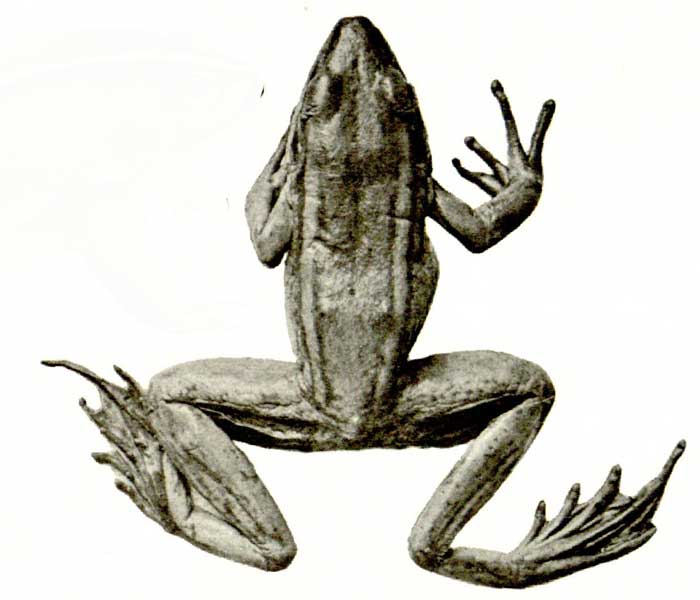Superregnum: Eukaryota
Cladus: Unikonta
Cladus: Opisthokonta
Cladus: Holozoa
Regnum: Animalia
Subregnum: Eumetazoa
Cladus: Bilateria
Cladus: Nephrozoa
Superphylum: Deuterostomia
Phylum: Chordata
Subphylum: Vertebrata
Infraphylum: Gnathostomata
Megaclassis: Osteichthyes
Cladus: Sarcopterygii
Cladus: Rhipidistia
Cladus: Tetrapodomorpha
Cladus: Eotetrapodiformes
Cladus: Elpistostegalia
Superclassis: Tetrapoda
Classis: Amphibia
Subclassis: Lissamphibia
Ordo: Anura
Familia: Ranidae
Genus: Hylarana
Species: Hylarana erythraea
Name
Hylarana erythraea (Schlegel, 1837)
Type locality: "Java" and "Sumatra", Indonesia.
Holotype: RMNH 1744 (4 specimens; Sumatra), 1746 (9 specimens; Sumatra), and 1749 (1 specimen; Sumatra) & MNHNP 4570-4572.

BW Photo of Hylarana erythraea
Synonyms
Hyla erythraea Schlegel, 1837
Hylarana erythraea — Tschudi, 1838
Limnodytes erythraeus — Duméril & Bibron, 1841
Hylorana erythraea — Günther, 1864
Rana erythraea — Boulenger, 1882
Rana (Hylorana) erythraea — Boulenger In Mason, 1882
Rana (Hylarana) erythraea — Müller, 1887
Rana (Limnodytes) erythraea — Bourret, 1927
Hylorana erythraea — Deckert, 1938
Polypedates erythraea — Bourret, 1942
Hylarana (Hylarana) erythraea — Fei, Ye & Huang, 1990
Hylarana erythraea — Che, Pang, Zhao, Wu, Zhao & Zhang, 2007
References
Schlegel, 1837, Abbild. Neuer Unvollst. Amph., 1: 27.
Che, Pang, Zhao, Wu, Zhao, and Zhang, 2007, Mol. Phylogenet. Evol., 42: 1–13.
Frost, D.R. 2021. Amphibian Species of the World: an Online Reference. Version 6.1. Electronic Database accessible at https://amphibiansoftheworld.amnh.org/index.php. American Museum of Natural History, New York, USA. DOI: 10.5531/db.vz.0001 Hylarana erythraea . Accessed on 29 June 2008.
2007 IUCN Red List of Threatened Species IUCN: Hylarana erythraea (Least Concern) Downloaded on 29 June 2008. (as Rana erythraea)
Vernacular names
English: Red-eared Frog
ไทย: เขียดจิก, กบบัว
The common green frog (Hylarana erythraea) is a frog species of in the true frog family Ranidae;[2] some sources still use the old name Rana erythraea. It lives in Southeast Asia and is also known as green paddy frog, red-eared frog or leaf frog.[1] The last name, however, commonly refers to the Neotropical tree frogs which make up the subfamily Phyllomedusinae. These are not closely related to H. erythraea, belonging to family Hylidae instead.
Taxonomy and systematics
Long placed in Rana, it is only as closely related to this genus as is e.g. Amolops. Consequently, the genus Hylarana, of which the common green frog is the type species, warrants re-establishment. Hylarana seems to form a clade together with the similarly revalidated genera Pulchrana and Sylvirana, and presumably also Hydrophylax as well as some species presently placed in Pelophylax (e.g. Kokarit Frog, "P." lateralis).[3]
This frog has confused researchers for a long time, as it resembles tree frogs in habitus. It was initially placed in the tree frog genus Hyla. The junior synonyms of the common green frog are:
Hyla erythraea Schlegel, 1837
Hylorana erythraea (lapsus)
Limnodytes erythraeus (Schlegel, 1837)
Polypedates erythraea (Schlegel, 1837)
Rana erythraea (Schlegel, 1837)
Description
Male Hylarana erythraea grow to a snout–vent length of 30–45 mm (1.2–1.8 in) and females to 50–75 mm (2.0–3.0 in). Tadpoles are up to 36 mm (1.4 in) in length. They have smooth skin that is bright green above and on sides. Tympanum is distinct.[4]
Distribution and ecology
H. erythraea occurs in Brunei, Cambodia, Indonesia, Laos, Malaysia, Myanmar, Singapore, Thailand, and Vietnam. Introduced populations are found on Sulawesi and the Philippines. The similar frogs from northeastern India and adjacent regions, formerly included here, are now separated as Hylarana tytleri.[1]
Its natural habitats are subtropical or tropical moist lowland forests, subtropical or tropical moist montane forests, freshwater lakes, intermittent freshwater lakes, freshwater marshes, intermittent freshwater marshes, rural gardens, heavily degraded former forest, irrigated land, seasonally flooded agricultural land, and introduced vegetation.[1]
Footnotes
IUCN SSC Amphibian Specialist Group (2014). "Hylarana erythraea". IUCN Red List of Threatened Species. 2014: e.T58593A64131003. doi:10.2305/IUCN.UK.2014-3.RLTS.T58593A64131003.en. Retrieved 13 November 2021.
Frost, Darrel R. (2014). "Hylarana erythraea (Schlegel, 1837)". Amphibian Species of the World: an Online Reference. Version 6.0. American Museum of Natural History. Retrieved 31 July 2014.
Stuart (2008), van Dijk et al. (2011)
"Hylarana erythraea". Amphibians and Reptiles of Peninsular Malaysia. Retrieved 31 July 2014.
References
IUCN SSC Amphibian Specialist Group (2014). "Hylarana erythraea". IUCN Red List of Threatened Species. 2014: e.T58593A64131003. doi:10.2305/IUCN.UK.2014-3.RLTS.T58593A64131003.en. Retrieved 13 November 2021.
Stuart, Bryan L. (2008): The phylogenetic problem of Huia (Amphibia: Ranidae). Mol. Phylogenet. Evol. 46(1): 49-60. doi:10.1016/j.ympev.2007.09.016 PDF fulltext
Retrieved from "http://en.wikipedia.org/"
All text is available under the terms of the GNU Free Documentation License


